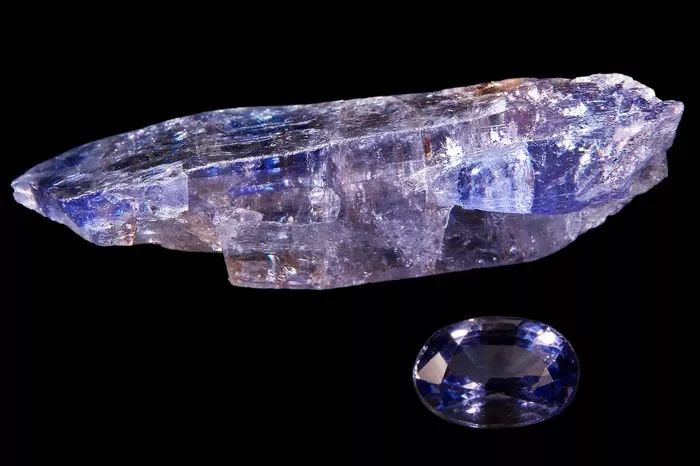Tanzanite, a remarkable gemstone admired for its captivating blue-violet hues, holds a special place in the world of gemstone enthusiasts and collectors. Discovered relatively recently in the foothills of Mount Kilimanjaro in Tanzania, this rare gemstone has gained popularity for its unique beauty and limited availability. In this article, we embark on a fascinating journey to explore the origins of tanzanite, its geological formation, and the specific regions where it is found. Join us as we unveil the captivating story of tanzanite and its exclusive sources around the world.
The Birth of Tanzanite
The tale of tanzanite begins in the late 1960s when a Maasai tribesman named Ali Juuyawatu stumbled upon vibrant blue crystals in the Merelani Hills of northern Tanzania. Captivated by their striking beauty, he brought the specimens to a prospector and gemologist named Manuel de Souza. Recognizing the extraordinary nature of these gems, de Souza named the gemstone “tanzanite” after its country of origin, Tanzania.
Geological Formation of Tanzanite
Tanzanite owes its existence to a unique combination of geological processes that occurred over millions of years. It is a variety of the mineral zoisite, which is composed of calcium aluminum silicate. The blue-violet color of tanzanite is a result of the presence of vanadium and traces of chromium within the crystal lattice structure of the mineral.
Tanzanite is formed through a complex process known as metamorphism. The metamorphic rocks in the Merelani Hills were subjected to intense heat and pressure, resulting from tectonic activity in the region. This geological transformation caused the original minerals to recrystallize and rearrange their atomic structure, giving birth to tanzanite.
Exclusive Tanzanite Sources
Tanzanite is an exceedingly rare gemstone and is found in only one location in the world—the Merelani Hills of northern Tanzania. This small area, encompassing approximately eight square miles, is the exclusive source of tanzanite. The Merelani Hills are situated in the Manyara Region, near the town of Arusha, which serves as a gateway to various Tanzanian national parks and attracts gemstone enthusiasts from around the world.
The gem-bearing veins in the Merelani Hills are embedded within graphite schists, which are metamorphic rocks formed from the alteration of sedimentary rocks rich in organic matter. These gem-bearing veins are relatively narrow and can range from a few centimeters to a couple of meters in width. Within these veins, pockets of tanzanite crystals are found, waiting to be discovered by skilled miners.
Mining Tanzanite
The mining process for tanzanite is a labor-intensive endeavor that requires expertise and precision. The mining operations in the Merelani Hills are primarily conducted through small-scale, artisanal methods. Miners carefully extract the graphite schists containing tanzanite veins using hand tools and explosives. Once the material is brought to the surface, it undergoes a meticulous sorting process, where experienced gemologists and miners separate the tanzanite crystals from the surrounding rock.
It is worth noting that tanzanite mining is subject to strict regulations in Tanzania to ensure sustainable extraction practices and protect the environment. The Tanzanian government plays an active role in overseeing the mining activities and implementing measures to prevent unauthorized mining and promote fair trade practices.
Tanzanite’s Global Appeal
Since its discovery, tanzanite has captured the attention of gemstone enthusiasts, jewelry designers, and collectors worldwide. Its exquisite blue-violet color, rarity, and connection to the African continent contribute to its allure and desirability. Tanzanite’s unique trichroic nature, displaying different colors when viewed from different angles, adds an element of fascination and makes each gemstone truly unique.
Jewelry featuring tanzanite has gained popularity, and the gemstone is often used in various designs, including rings, pendants, earrings, and bracelets. Its vibrant blue-violet hue complements both white and yellow metals, allowing for versatile and captivating jewelry creations.
The Future of Tanzanite
The future of tanzanite is intertwined with the responsible and sustainable mining practices in the Merelani Hills. The Tanzanian government, in collaboration with various stakeholders, is committed to ensuring the long-term viability of tanzanite mining while protecting the environment and promoting fair trade. Efforts are underway to educate miners about responsible mining techniques and environmental conservation, ensuring that future generations can continue to appreciate the beauty of tanzanite.
Conclusion
Tanzanite’s journey, from its humble discovery to becoming a treasured gemstone, is a testament to its rare and captivating nature. Found exclusively in the Merelani Hills of Tanzania, tanzanite stands as a testament to the geological wonders of our planet. Its deep blue-violet hues, formed through intricate geological processes, have fascinated gemstone enthusiasts and jewelry lovers around the globe. As we conclude our exploration of tanzanite’s origins, we invite you to immerse yourself in the beauty and allure of this exceptional gemstone, appreciating its rarity and the remarkable story that lies within each exquisite tanzanite gem.


